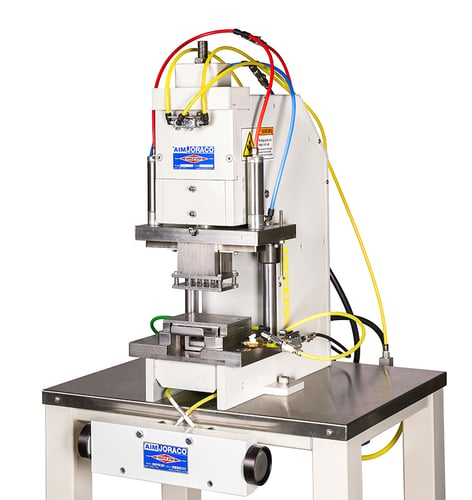Using Pneumatic Presses to Degate Injection Molded Parts
In the world of injection molding, efficiency and precision are critical. After injection molding, one of the key steps in the manufacturing process is degating—the removal of excess material, known as the gate, that connects the molded part to the runner system. This step is essential to ensure the final product meets quality standards and is ready for its intended application.
One of the most effective tools for degating critical injection molded parts is a pneumatic press. In this article, we will explore how a pneumatic press simplifies the degating process, and best practices for their use.
What is a Pneumatic Press?
A pneumatic press is a machine that uses compressed air to apply force for various industrial applications, including pressing, punching, and cutting. In the context of injection molding, pneumatic presses are used to remove gates from molded parts quickly and efficiently. These presses are favored for their speed, efficiency, and ability to handle high-volume production.
How Pneumatic Presses Work in Degating
Pneumatic presses operate by utilizing compressed air to drive a piston, which in turn generates the force needed to cut or shear the gate from the molded part. The press is equipped with a die or blade that matches the specific design of the part, ensuring a clean and precise cut. The operator places the part on the press, aligns it with the cutting tool, and activates the press, which then removes the gate in a single motion.
Benefits of Using Pneumatic Presses for Degating
- Precision and Consistency: Pneumatic presses, particularly toggle presses, offer precise control over the force applied during the degating process. This ensures that each part is degated with the same level of accuracy, reducing variability and improving overall product quality.
- Speed: The speed of a pneumatic press allows for rapid degating, which is crucial in high-volume production environments. The quick cycle times help manufacturers meet tight deadlines and maintain efficient production lines. When included in a PLC controlled automated set up, a pneumatic press can handle over 120 cycles per minute.
- Cost-Effective: Pneumatic presses are relatively simple machines with fewer moving parts compared to hydraulic systems. This simplicity translates to lower maintenance costs and reduced downtime, making them a cost-effective choice for many manufacturers.
- Safety: Modern pneumatic presses are equipped with safety features such as two-hand operation controls, emergency stop buttons, and guards that protect operators from injury. These features help create a safer working environment. On most presses, electricity is not even needed in the configuration.
- Versatility: Pneumatic presses can be easily adjusted to accommodate different part sizes and shapes, making them versatile tools for manufacturers who produce a variety of molded parts.
 Best Practices for Using Pneumatic Presses in Degating
Best Practices for Using Pneumatic Presses in Degating
- Tooling Design: The design of the cutting tool or die is critical for achieving a clean cut. It should be tailored to the specific geometry of the part to minimize the risk of damaging the part during degating. Using die sets and integrated into C-Frame toggle presses, tooling can accurately degate even the smallest, most critical parts such as in electronic and medical instruments.
- Regular Maintenance: To ensure the longevity and reliability of the pneumatic press, regular maintenance is essential. This includes checking for air leaks, inspecting the cutting tool for wear, and ensuring that all safety features are functioning properly. Normally, only minimal lubrication is needed on external parts and an FRL will lubricate internal valve components.
- Operator Training: Proper training for operators is crucial to ensure safe and efficient use of the pneumatic press. Operators should be familiar with the machine's controls, safety features, and maintenance procedures.
- Quality Control: Implementing quality control measures, such as regular inspections of degated parts, can help identify any issues early in the process. This ensures that only parts that meet quality standards move on to the next stage of production.
Conclusion
Pneumatic presses have become an invaluable tool in the degating process for injection molded metal and plastic parts. Their speed, precision, and cost-effectiveness make them an excellent choice for manufacturers looking to improve efficiency and product quality. By following best practices in tooling design, maintenance, operator training, and quality control, manufacturers can maximize the benefits of pneumatic presses and stay competitive in the fast-paced world of injection molding.
About Joraco Press Company
Joraco Press Company has been an innovator in the pneumatic press industry since 1947. The trademarked TOGGLE-AIRE® Series has been the core product of Joraco Press for over 60 years having been installed in thousands of manufacturing facilities all over the world. The past 20 years have seen Joraco Press expand its benchtop pneumatic press products to cover more applications and more force ranges than ever before. Joraco Press Company is a division of Automated Industrial Machine, Inc located in Smithfield, RI. Our products are designed, fabricated, and assembled at the AIM headquarters and as always, the same people who build our presses are always available to help troubleshoot your press.
Comments
Subscribe here to be alerted when we post new articles!
Are you ready to place an order?
Ordering a standard press from Joraco Press Company is easy! Send us a Quote Request and we will respond quickly with a detailed Estimate. Specify the press you need, the force your application requires, and specifications about your project so we can confirm your requirements. Just reference the Estimate in your Purchase Order!
